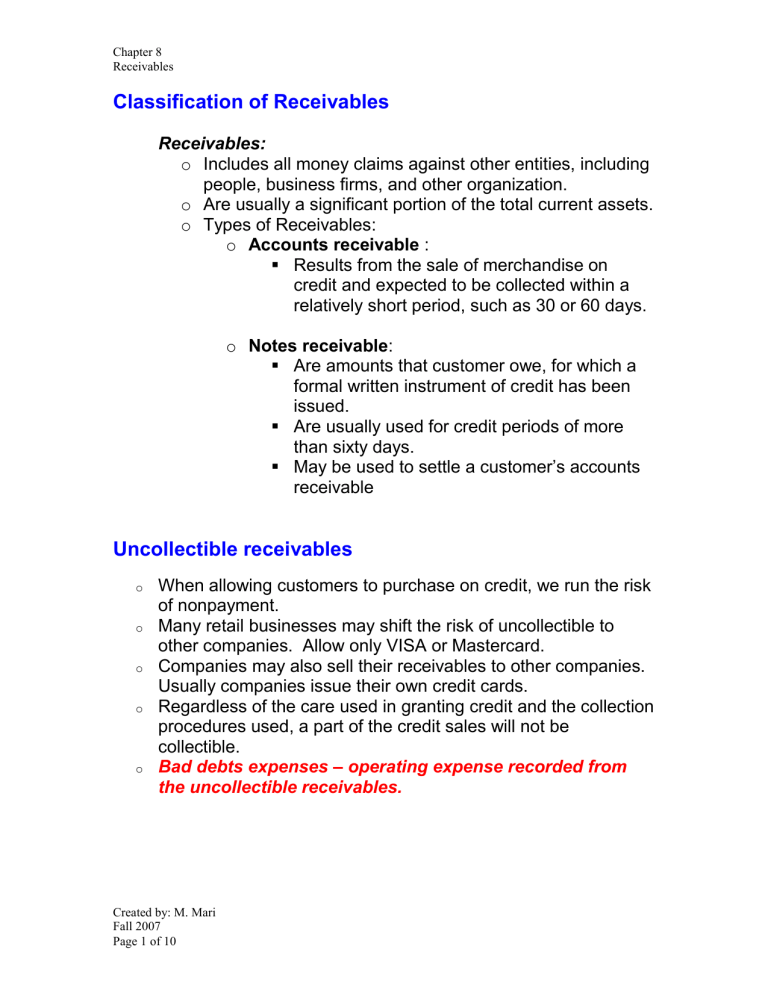Classification of Receivables

Chapter 8
Receivables
Classification of Receivables
Receivables: o Includes all money claims against other entities, including people, business firms, and other organization. o Are usually a significant portion of the total current assets. o Types of Receivables: o Accounts receivable :
Results from the sale of merchandise on credit and expected to be collected within a relatively short period, such as 30 or 60 days. o Notes receivable :
Are amounts that customer owe, for which a formal written instrument of credit has been issued.
Are usually used for credit periods of more than sixty days.
May be used to settle a customer’s accounts receivable
Uncollectible receivables
o o
When allowing customers to purchase on credit, we run the risk of nonpayment.
Many retail businesses may shift the risk of uncollectible to other companies. Allow only VISA or Mastercard.
o o o
Companies may also sell their receivables to other companies.
Usually companies issue their own credit cards.
Regardless of the care used in granting credit and the collection procedures used, a part of the credit sales will not be collectible.
Bad debts expenses – operating expense recorded from the uncollectible receivables.
Created by: M. Mari
Fall 2007
Page 1 of 10
Chapter 8
Receivables
Remember from
Chapter 1 !
Two methods of accounting for receivables:
1. Allowance method
2. Direct write off method
Allowance method:
Required by generally accepted accounting principles
(GAAP)
Estimates the accounts receivable that will not be collected and records bad debt expense for this estimate at the end of each accounting period.
We create a CONTRA ASSET ACCOUNT called Allowance
for Bad Debts. It increases with a credit.
Record the total estimate that has not been written off.
Entry is considered an adjusting entry.
Example 1: Suppose that accounts receivable have a balance of
$105,000 and it is estimated that $4,000 will go bad in the next period.
Date
May
21
Uncollectible account expense
Account Pr Debit
4,000
Credit
Allowance for bad debts 4,000
Net Realizable Value =
Accounts receivable balance – Allowance for bad debts
What is really expected to be collected!
Why?
Matching principle
Created by: M. Mari
Fall 2007
Page 2 of 10
Chapter 8
Receivables
Write offs to the Allowance Account o Once that we determine that a particular customer will be not collectible, we write off the account. o The write off consists of reducing the allowance account by the amount of the write off and removing the uncollectible account from accounts receivable.
Example 2: Suppose that J Mays account with a balance of $1,200 is uncollectible.
Date
May
31
Account
Allowance account
Accounts receivable
Pr Debit
1,200
Credit
1,200
Estimating Uncollectibles
o The allowance method estimates bad debts expense at the end of the period. o Estimate of uncollectibles at the end of a fiscal period is based on past experience and forecasts of the future. o Two methods are used: o Estimated based on percentage of sales o Analysis of accounts receivable.
Estimate Based on Sales: o We assume that a percentage of credit sales will go bad and record that as the adjusting entry.
Created by: M. Mari
Fall 2007
Page 3 of 10
Chapter 8
Receivables
Example 3: Suppose that credit sales for the period were $800,000 of which 1% is expected to be uncollectible. Record the entry.
$800,000 x 1% = $ 8,000
Account Pr Debit Credit
May
21
Uncollectible account expense
Allowance account
8,000
8,000
Example 4: Suppose that the company expects 3% of credit sales to go uncollected. A review of the trial balance shows:
Sales $1,000,000 of which 45% are cash sales.
Accounts receivable has a balance of $70,000.
Allowance for bad debts has credit balance of $2,000.
Credit sales are $1,000,000 x 55% = $550,000
Estimate is $550,000 x 3% = $16,500
Allowance for Bad Debts
DEBIT CREDIT
$2,000 balance
$16,500 should be balance
As a result of the credit balance in the Allowance account, we will record the entry not for $16,500 but $14,500 ( $16,500 - $2,000).
Date
May
21
Uncollectible account expense
Account Pr Debit
14,500
Credit
Allowance account 14,500
Created by: M. Mari
Fall 2007
Page 4 of 10
Chapter 8
Receivables
Example 5: Suppose that the company expects 3% of credit sales to go uncollected. A review of the trial balance shows:
Sales $1,000,000 of which 45% are cash sales.
Accounts receivable has a balance of $70,000.
Allowance for bad debts has debit balance of $2,000.
Credit sales are $1,000,000 x 55% = $550,000
Estimate is $550,000 x 3% = $16,500
Allowance for Bad Debts
DEBIT
$2,000 balance
CREDIT
$16,500 should be balance
As a result of the debit balance in the Allowance account, we will record the entry not for $16,500 but $18,500 ( $16,500 + $2,000).
Date
May
21
Uncollectible account expense
Account Pr Debit
18,500
Credit
Allowance account 18,500
When the Allowance Account at the end of the year:
Has a debit balance
we underestimated the bad debts last period.
Has a credit balance
we overestimated the bad debts last period.
Created by: M. Mari
Fall 2007
Page 5 of 10
Chapter 8
Receivables
Estimate Based on Analysis of Receivables
This is done through an aging of accounts receivables
Age Interval
Not past due
1 –30
31 – 60
61 – 90
91 – 180
181 – 365
Over 365
Date
May
21
Balance
$75,000
Uncollectible account expense
Account
$4,000
$3,100
$1,900
$1,200
$800
$300
Percent
Pr
2%
5%
10%
20%
30%
50%
80%
Debit
3,390
Amount
$1,500
$200
$310
$380
$360
$400
$240
Total $86,300
The aging is done by multiplying the balance times the percent to get the
$3,390 amount .
Credit
Allowance account 3,390
Direct Write off Method
There is no estimated uncollectibles
There is no allowance account
Only when a specific customer goes bad will it be written off to the expense account.
Suppose that Haby’s account goes bad with a balance of
$8,000.
Date
May
21
Uncollectible account expense
Account Pr Debit
8,000
Credit
Accounts receivable 8,000
Created by: M. Mari
Fall 2007
Page 6 of 10
Chapter 8
Receivables
Reinstatements of Write offs:
Allowance method:
Date Account
May 21 Accounts receivable
Debit
$8,000
Credit
Allowance account $8,000
F or the amount originally written off then record the collection of funds.
Direct Write off Method:
Date Account Debit Credit
May 21 Accounts receivable $8,000
Bad Debts expense $8,000
For the amount originally written off then record the collection of funds.
Characteristics of Notes Receivable:
Promissory note – is a written promise to pay a sum of money on demand or at a definite time.
Payee – the person to whom the note is payable to
Maker – one making the note and owing the money
Due date – when the note is due
Maturity value = principal + interest
Created by: M. Mari
Fall 2007
Page 7 of 10
Before calculators easier to use
360 days to make calculations
Chapter 8
Receivables
Computation of Due Date o The length of time that the note is open is usually stated in days or months. o Use 360 day year for easy of computation in class but in real life we use 365 day year.
Example: Suppose that a note is issued on May 1 st for 60 days when is the note due.
May 31 days in May
-1 date the note is issued
30 days the note exists in May
60 days in the note
30 Date in June the note is due.
Computation of Interest due
Principal X Rate X Time = Interest
Amount owed on note
Percentage of interest charged
Days on note
360
Amount in dollars spent on interest
Example: Suppose that face or principal of note is $30,000, interest rate is 10% for 60 days.
Principal X Rate X Time = Interest
$30,000 X 10% X 60/360 = $500 interest due with note
Maturity value = Principal + Interest
= $30,000 + $500
= $30, 500
Created by: M. Mari
Fall 2007
Page 8 of 10
Chapter 8
Receivables
Example: Suppose that a note for $20,000 with 12% is issued on
June 5 for 90 days. Compute the due date, interest, and maturity value of the note.
Accounting for Notes Receivables o A customer may use a note to replace an account receivable.
o This causes the creation of a note receivable and the removal of the outstanding accounts receivable.
Example: Suppose that the account for Mister is past due. Mister converts the receivable to a note for 60 days at 10%. The balance is
$6,000.
Date Account
May 21 Notes receivable
Accounts receivable
Date
Mister pays amount due on the date.
Cash
Account
Pr
Pr
Debit
$6,000
Debit
$6,100
Credit
$6,000
Credit
Notes receivable
Interest receivable
When the note is paid on the due date, it said that the note is
HONORED.
$6,000
$100
Dishonored Notes o When the maker does not pay the maturity value on the due date, the note is said to be DISHONORED o At this time, the note ceases to exist, the maturity value of the note is reported again as an Accounts Receivable.
Created by: M. Mari
Fall 2007
Page 9 of 10
Chapter 8
Receivables o We include the interest computed as income earned but not yet received.
Example: Suppose that the account for Mister is past due. Mister converts the receivable to a note for 60 days at 10%. The balance is
$6,000. On the due date, the note becomes dishonored
Recording dishonored note
Date Account
Accounts receivable
Pr Debit
$6,100
Credit
$6,000 Notes receivable
Interest receivable $100
Notice that the difference is that we debit accounts receivables instead of cash.
Created by: M. Mari
Fall 2007
Page 10 of 10



